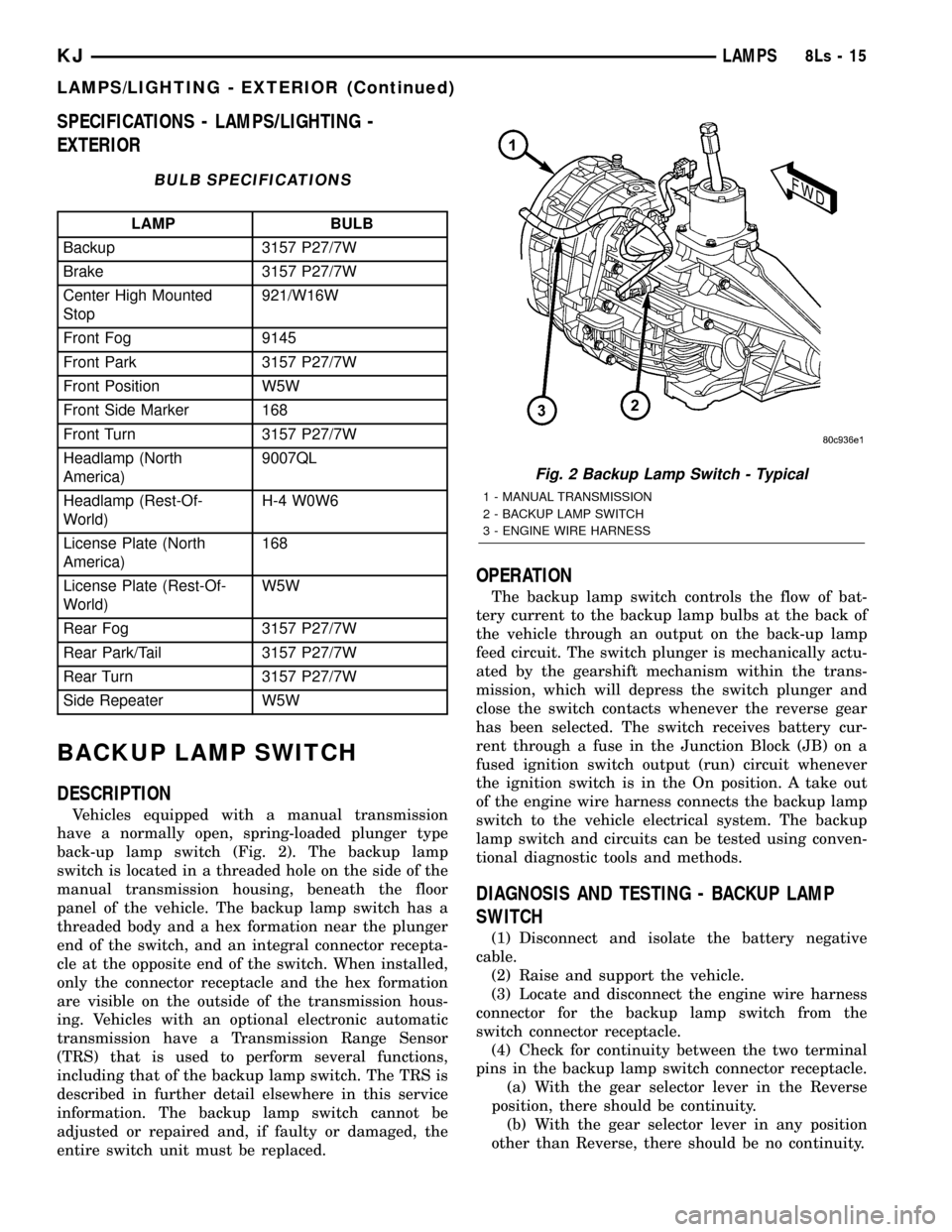Ignition control JEEP LIBERTY 2002 KJ / 1.G Workshop Manual
[x] Cancel search | Manufacturer: JEEP, Model Year: 2002, Model line: LIBERTY, Model: JEEP LIBERTY 2002 KJ / 1.GPages: 1803, PDF Size: 62.3 MB
Page 540 of 1803

SPECIFICATIONS - LAMPS/LIGHTING -
EXTERIOR
BULB SPECIFICATIONS
LAMP BULB
Backup 3157 P27/7W
Brake 3157 P27/7W
Center High Mounted
Stop921/W16W
Front Fog 9145
Front Park 3157 P27/7W
Front Position W5W
Front Side Marker 168
Front Turn 3157 P27/7W
Headlamp (North
America)9007QL
Headlamp (Rest-Of-
World)H-4 W0W6
License Plate (North
America)168
License Plate (Rest-Of-
World)W5W
Rear Fog 3157 P27/7W
Rear Park/Tail 3157 P27/7W
Rear Turn 3157 P27/7W
Side Repeater W5W
BACKUP LAMP SWITCH
DESCRIPTION
Vehicles equipped with a manual transmission
have a normally open, spring-loaded plunger type
back-up lamp switch (Fig. 2). The backup lamp
switch is located in a threaded hole on the side of the
manual transmission housing, beneath the floor
panel of the vehicle. The backup lamp switch has a
threaded body and a hex formation near the plunger
end of the switch, and an integral connector recepta-
cle at the opposite end of the switch. When installed,
only the connector receptacle and the hex formation
are visible on the outside of the transmission hous-
ing. Vehicles with an optional electronic automatic
transmission have a Transmission Range Sensor
(TRS) that is used to perform several functions,
including that of the backup lamp switch. The TRS is
described in further detail elsewhere in this service
information. The backup lamp switch cannot be
adjusted or repaired and, if faulty or damaged, the
entire switch unit must be replaced.
OPERATION
The backup lamp switch controls the flow of bat-
tery current to the backup lamp bulbs at the back of
the vehicle through an output on the back-up lamp
feed circuit. The switch plunger is mechanically actu-
ated by the gearshift mechanism within the trans-
mission, which will depress the switch plunger and
close the switch contacts whenever the reverse gear
has been selected. The switch receives battery cur-
rent through a fuse in the Junction Block (JB) on a
fused ignition switch output (run) circuit whenever
the ignition switch is in the On position. A take out
of the engine wire harness connects the backup lamp
switch to the vehicle electrical system. The backup
lamp switch and circuits can be tested using conven-
tional diagnostic tools and methods.
DIAGNOSIS AND TESTING - BACKUP LAMP
SWITCH
(1) Disconnect and isolate the battery negative
cable.
(2) Raise and support the vehicle.
(3) Locate and disconnect the engine wire harness
connector for the backup lamp switch from the
switch connector receptacle.
(4) Check for continuity between the two terminal
pins in the backup lamp switch connector receptacle.
(a) With the gear selector lever in the Reverse
position, there should be continuity.
(b) With the gear selector lever in any position
other than Reverse, there should be no continuity.
Fig. 2 Backup Lamp Switch - Typical
1 - MANUAL TRANSMISSION
2 - BACKUP LAMP SWITCH
3 - ENGINE WIRE HARNESS
KJLAMPS8Ls-15
LAMPS/LIGHTING - EXTERIOR (Continued)
Page 544 of 1803

INSTALLATION
CAUTION: Always use the correct bulb size and
type for replacement. An incorrect bulb size or type
may overheat and cause damage to the lamp, the
socket and/or the lamp wiring.
(1) Align the base of the bulb with the receptacle
in the Center High Mounted Stop Lamp (CHMSL)
unit socket.
(2) Push the bulb straight into the CHMSL unit
socket until it is firmly seated.
(3) Align the socket and bulb with the socket open-
ing on the back of CHMSL unit housing.
(4) Push the socket and bulb straight into the
CHMSL unit housing until it is firmly seated (Fig. 6).
(5) Rotate the socket on the back of the CHMSL
unit housing clockwise about 30 degrees.
(6) Reinstall the CHMSL unit onto the roof panel.
(Refer to 8 - ELECTRICAL/LAMPS/LIGHTING -
EXTERIOR/CENTER HIGH MOUNTED STOP
LAMP UNIT - INSTALLATION).
(7) Reconnect the battery negative cable.
CENTER HIGH MOUNTED
STOP LAMP UNIT
REMOVAL
(1) Disconnect and isolate the battery negative
cable.
(2) Remove the two screws that secure the Center
High Mounted Stop Lamp (CHMSL) unit to the rear
of the roof panel (Fig. 7).
(3) Pull the CHMSL unit away from the roof panel
far enough to access and disconnect the wire harness
connector for the CHMSL unit from the lamp socket
pigtail wire.
(4) Remove the CHMSL unit from the roof panel.
INSTALLATION
(1) Position the Center High Mounted Stop Lamp
(CHMSL) unit to the roof panel.
(2) Reconnect the wire harness connector for the
CHMSL unit to the lamp socket pigtail wire (Fig. 7).
(3) Position the CHMSL unit into the roof panel
opening.
(4) Install and tighten the two screws that secure
the CHMSL unit to the rear of the roof panel.
Tighten the screws to 2 N´m (21 in. lbs.).
(5) Reconnect the battery negative cable.
COMBINATION FLASHER
DESCRIPTION
The combination flasher for this model is integral
to the hazard switch located in the center of the
instrument panel, just above the radio. The combina-
tion flasher is a smart relay that functions as both
the turn signal system and the hazard warning sys-
tem flasher. The combination flasher contains active
electronic Integrated Circuitry (IC) elements. This
flasher is designed to handle the current flow
requirements of the factory-installed lighting. If sup-
plemental lighting is added to the turn signal lamp
circuits, such as when towing a trailer with lights,
the combination flasher will automatically try to
compensate to keep the flash rate the same.
The combination flasher cannot be repaired or
adjusted and, if faulty or damaged, the hazard switch
unit must be replaced.
OPERATION
The combination flasher has the following inputs and
outputs: fused B(+), fused ignition switch output, right
turn signal sense, left turn signal sense, and one out-
put each for the right and left turn signal circuits. The
combination flasher also receives an internal input
through the closed contacts of the hazard switch and,
on vehicles equipped with the optional Vehicle Theft
Security System (VTSS), the flasher receives an input
from the Body Control Module (BCM) in order to flash
the turn signal lamps as an optical alert feature of that
Fig. 7 Center High Mounted Stop Lamp Remove/
Install
1 - ROOF PANEL
2 - BODY WIRE HARNESS CONNECTOR
3 - BULB SOCKET
4 - CHMSL
5 - SCREW (2)
6 - PLASTIC NUT (2)
KJLAMPS8Ls-19
CENTER HIGH MOUNTED STOP LAMP BULB (Continued)
Page 545 of 1803

system. Constant battery voltage is supplied to the
flasher so that it can perform the hazard warning func-
tion, and ignition switched battery voltage is supplied
for the turn signal function. The Integrated Circuit (IC)
within the combination flasher contains the logic that
controls the flasher operation and the flash rate. The
IC receives separate sense ground inputs from the
multi-function switch for the right and left turn sig-
nals, and from the hazard switch contacts or the BCM
for the hazard warning signals. A special design feature
of the combination flasher allows it to9sense9that a
turn signal circuit or bulb is not operating, and provide
the driver an indication of the condition by flashing the
remaining bulbs in the affected circuit at a higher rate
(120 flashes-per-minute or higher). Conventional flash-
ers either continue flashing at their typical rate (heavy-
duty type), or discontinue flashing the affected circuit
entirely (standard-duty type).
Because of the active electronic elements within
the combination flasher, it cannot be tested with con-
ventional automotive electrical test equipment. If the
combination flasher is believed to be faulty, test the
turn signal and hazard warning system. Then
replace the hazard switch with a known good unit to
confirm system operation.
DAYTIME RUNNING LAMP
RELAY
DESCRIPTION
The Daytime Running Lamp (DRL) relay (Fig. 8) is
a solid state relay that is used only on vehicles man-
ufactured for sale in Canada. The DRL relay featuresa die cast aluminum housing with integral cooling
fins that act as a heat sink for the solid state DRL
circuitry. Four male spade terminals extend from the
base of the relay through a potting material that
encloses and protects the DRL circuitry. Although the
DRL relay has four terminals that are laid out in a
footprint that is similar to that of a conventional
International Standards Organization (ISO) relay, a
standard ISO relay should never be installed in place
of the DRL relay. The DRL relay is installed in the
Junction Block (JB) on the driver side outboard end
of the instrument panel. Vehicles equipped with this
relay do not have a headlamp high beam relay
installed in the JB.
The DRL relay cannot be adjusted or repaired and,
if faulty or damaged, the unit must be replaced.
OPERATION
The Daytime Running Lamp (DRL) relay is a solid
state relay that controls the flow of battery current
to the high beam filaments of both headlamp bulbs
based upon a duty cycled control input received from
the Body Control Module (BCM) of vehicles equipped
with the DRL feature. By cycling the DRL relay out-
put, the BCM controls the illumination intensity of
the high beam filaments. The DRL relay terminals
are connected to the vehicle electrical system through
a connector receptacle in the Junction Block (JB).
The inputs and outputs of the DRL relay include:
²Battery Current Input- The DRL relay
receives battery current on a fused B(+) circuit from
a fuse in the Power Distribution Center (PDC).
²Ground Input- The DRL relay receives a path
to ground through a splice block located in the
instrument panel wire harness with an eyelet termi-
nal connector that is secured by a nut to a ground
stud on the driver side instrument panel end bracket
near the Junction Block (JB).
²Control Input- The DRL relay control input is
received from the BCM and/or the momentary optical
horn (flash-to-pass) output of the multi-function
switch through a high beam relay control circuit.
²Control Output- The DRL relay supplies bat-
tery current output to the headlamp high beam fila-
ments through the high beam relay output circuit.
Because of active electronic elements within the
DRL relay, it cannot be tested with conventional
automotive electrical test equipment. If the DRL
relay is believed to be faulty, replace the relay with a
known good unit to confirm system operation.
Fig. 8 Daytime Running Lamp Relay
1 - DRL RELAY
2 - HEAT SINK
3 - POTTING MATERIAL
4 - TERMINAL (4)
8Ls - 20 LAMPSKJ
COMBINATION FLASHER (Continued)
Page 554 of 1803

switch module housing is the hazard switch circuitry
and an electronic circuit board with the integral com-
bination flasher circuitry. The electronic combination
flasher circuitry performs both the hazard flasher
and turn signal flasher functions.
The hazard switch module cannot be adjusted or
repaired and, if faulty or damaged, the unit must be
replaced.
OPERATION
The hazard switch button is slightly recessed in
the instrument panel when the switch is in the Off
position, and latches at a position that is flush with
the outer surface of the instrument panel when in
the On position. The hazard switch module produces
an audible clicking sound that emulates the sound of
a conventional flasher whenever the turn signals or
the hazard warning system are activated. The hazard
switch module receives battery current on a fused
B(+) circuit from a fuse in the Junction Block (JB) at
all times for operation of the hazard warning, and on
a fused ignition switch output (run) circuit from
another fuse in the JB whenever the ignition switch
is in the On position for operation of the turn signals.
The module receives a path to ground through a
splice block located in the instrument panel wire har-
ness with an eyelet terminal connector that is
secured by a nut to a ground stud on the driver side
instrument panel end bracket near the JB. Inputs to
and outputs from the hazard switch module include:
²Panel Lamps Dimmer Input- A non-service-
able incandescent bulb soldered onto the hazard
switch module circuit board provides illumination of
the switch button when the exterior lighting is
turned On through an input received on the fusedpanel lamps dimmer switch signal circuit. However,
this bulb flashes on and off at full intensity whenever
the hazard switch button is in the On position,
regardless of the status of the exterior lighting.
²Hazard Switch Input- The combination
flasher circuitry of the hazard switch module receives
an internal ground input from the hazard switch to
request hazard flasher operation.
²Multi-Function Switch Input- The combina-
tion flasher circuitry of the hazard switch module
receives separate ground inputs from the turn signal
switch circuitry of the multi-function switch on right
and left turn switch sense circuits to request right or
left turn signal flasher operation.
²Body Control Module Input- The Body Con-
trol Module (BCM) can request hazard flasher opera-
tion by providing a ground path to the combination
flasher circuitry of the hazard switch module through
a hazard lamp control circuit.
²Turn Signal Output- The combination flasher
circuitry within the hazard switch module responds
to the flasher request inputs by energizing and
de-energizing two miniature relays on the module
circuit board. These relays control the switch output
through the right and left turn signal circuits. One
relay controls the right lamps, while the other con-
trols the left.
Because of active electronic elements within the
hazard switch module, it cannot be tested with con-
ventional automotive electrical test equipment. If the
hazard switch module is believed to be faulty, replace
the switch with a known good unit to confirm system
operation.
REMOVAL
WARNING: ON VEHICLES EQUIPPED WITH AIR-
BAGS, DISABLE THE SUPPLEMENTAL RESTRAINT
SYSTEM BEFORE ATTEMPTING ANY STEERING
WHEEL, STEERING COLUMN, DRIVER AIRBAG,
PASSENGER AIRBAG, SEAT BELT TENSIONER,
FRONT IMPACT SENSORS, SIDE CURTAIN AIRBAG,
OR INSTRUMENT PANEL COMPONENT DIAGNOSIS
OR SERVICE. DISCONNECT AND ISOLATE THE
BATTERY NEGATIVE (GROUND) CABLE, THEN
WAIT TWO MINUTES FOR THE SYSTEM CAPACI-
TOR TO DISCHARGE BEFORE PERFORMING FUR-
THER DIAGNOSIS OR SERVICE. THIS IS THE ONLY
SURE WAY TO DISABLE THE SUPPLEMENTAL
RESTRAINT SYSTEM. FAILURE TO TAKE THE
PROPER PRECAUTIONS COULD RESULT IN ACCI-
DENTAL AIRBAG DEPLOYMENT AND POSSIBLE
PERSONAL INJURY.
(1) Disconnect and isolate the battery negative
cable.
Fig. 21 Hazard Switch
1 - HAZARD SWITCH BUTTON
2 - SCREW (1)
3 - MOUNTING BRACKET TABS
KJLAMPS8Ls-29
HAZARD SWITCH (Continued)
Page 573 of 1803

²Parade Mode- The internal circuitry and hard-
ware of the multi-function switch left (lighting) con-
trol stalk provide detent switching for a parade mode
that maximizes the illumination intensity of all
instrument panel lighting for visibility when driving
in daylight with the exterior lamps turned on.
²Park Lamps- The internal circuitry and hard-
ware of the multi-function switch left (lighting) con-
trol stalk provide detent switching for the park
lamps.
²Rear Fog Lamps- For vehicles so equipped,
the internal circuitry and hardware of the multi-
function switch left (lighting) control stalk provide
detent switching for the optional rear fog lamps.
Rear fog lamps are optional only for vehicles manu-
factured for certain markets, where they are
required.
²Turn Signal Control- The internal circuitry
and hardware of the multi-function switch left (light-
ing) control stalk provide both momentary non-detent
switching and detent switching with automatic can-
cellation for both the left and right turn signal
lamps.
RIGHT CONTROL STALK The right (wiper) con-
trol stalk of the multi-function switch supports the
following functions and features:
²Continuous Front Wipe Modes- The internal
circuitry and hardware of the multi-function switch
right (wiper) control stalk provide two continuous
front wipe switch positions, low speed or high speed.
²Continuous Rear Wipe Mode- The internal
circuitry and hardware of the multi-function switch
right (wiper) control stalk provide one continuous
rear wipe switch position.
²Front Washer Mode- The internal circuitry
and hardware of the multi-function switch right
(wiper) control stalk switch provide front washer sys-
tem operation.
²Front Wipe-After-Wash Mode- The internal
circuitry and hardware of the multi-function switch
right (wiper) control stalk provide a wipe-after-wash
mode.
²Front Wiper Mist Mode- The internal cir-
cuitry and hardware of the multi-function switch
right (wiper) control stalk provide a front wiper sys-
tem mist mode.
²Intermittent Front Wipe Mode- The internal
circuitry and hardware of the multi-function switch
right (wiper) control stalk provide an intermittent
front wipe mode with five delay interval positions.
²Intermittent Rear Wipe Mode- The internal
circuitry and hardware of the multi-function switch
right (wiper) control stalk provide one fixed interval
intermittent rear wipe mode switch position.²Rear Washer Mode- The internal circuitry and
hardware of the multi-function switch right (wiper)
control stalk provide rear washer system operation.
OPERATION
The multi-function switch uses a combination of
resistor multiplexed and conventionally switched out-
puts to control the many functions and features it
provides. The switch receives battery current on a
fused ignition switch output (run-acc) circuit from a
fuse in the Junction Block (JB) whenever the ignition
switch is in the On or Accessory positions. The switch
receives a path to ground at all times through a
splice block located in the instrument panel wire har-
ness with an eyelet terminal connector that is
secured by a nut to a ground stud on the driver side
instrument panel end bracket near the Junction
Block (JB). Following are descriptions of how each of
the two multi-function switch control stalks operate
to control the functions and features they provide.
LEFT CONTROL STALK The left (lighting) control
stalk of the multi-function switch operates as follows:
²Front Fog Lamps- For vehicles so equipped,
the control knob on the end of the multi-function
switch left (lighting) control stalk is pulled outward
to activate the optional front fog lamps. The control
knob is mechanically keyed so that it cannot be
pulled outward unless it is first rotated to turn on
the exterior lighting. The multi-function switch pro-
vides a resistor multiplexed output to the Body Con-
trol Module (BCM) on a fog lamp switch sense
circuit, and the BCM responds by energizing or de-
energizing the front fog lamp relay in the Junction
Block (JB) as required.
²Headlamps-
The control knob on the end of the
multi-function switch left (lighting) control stalk is
rotated forward (counterclockwise) to its second detent
position to activate the headlamps. The multi-function
switch provides a resistor multiplexed output to the
Body Control Module (BCM) on a headlamp switch
sense circuit, and the BCM responds by energizing or
de-energizing the selected low or high beam relay
(Daytime Running Lamp relay in Canadian vehicles)
in the Junction Block (JB) as required.
²Headlamp Beam Selection-The left (lighting)
control stalk of the multi-function switch is pulled
towards the steering wheel past a detent to actuate
the integral beam select switch circuitry. Each time the
control stalk is activated in this manner, the opposite
headlamp beam from what is currently selected will be
energized. The multi-function switch provides a ground
output to the Body Control Module (BCM) on a high
beam switch sense circuit, and the BCM responds by
energizing or de-energizing the selected low or high
beam relay (Daytime Running Lamp relay in Canadian
vehicles) in the Junction Block (JB) as required.
8Ls - 48 LAMPSKJ
MULTI-FUNCTION SWITCH (Continued)
Page 590 of 1803

LAMP BAR
DESCRIPTION
The lamp bar is used to better illuminate the driv-
ers field of vision under certain driving conditions. It
consists of a cover, two or four lamp assemblies
(depending upon which market), and a wiring har-
ness. These components are mounted to a reinforce-
ment, then sealed and secured to the roof panel.
Lamp bar illumination is controlled by a manually
operated momentary rocker switch, mounted to the
instrument panel. The lamps are adjustable in the
vertical position only.
OPERATION
Battery and ignition voltage are supplied to the
lamp bar switch assembly. When the switch is in the
on position the internal relay contacts close, complet-
ing the circuit through the lamp bar bulbs, to
ground. The lamp bar assembly is grounded to the
chassis. The hard wired circuits of the lamp bar may
be diagnosed and tested using conventional methods
and procedures.
DIAGNOSIS AND TESTING - LAMP BAR
CONDITION POSSIBLE CAUSES CORRECTION
LAMP BAR LAMPS
INOPERATIVEFaulty or missing fuse Test and replace lamp bar fuse
as required
Faulty feed circuit Test and repair open battery or
ignition feed circuit.
Faulty ground circuit Test and repair high resistance
or open lamp bar ground circuit
Faulty lamp bar sense circuit Test and repair short to voltage
in lamp bar sense circuit
Faulty switch Test and replace lamp bar
switch
LAMP BAR LAMPS ON AT
ALL TIMESFaulty switch Test and replace lamp bar
switch
Lamp bar feed circuit Test and repair short to voltage
in lamp bar feed circuit
ONE OR MORE LAMPS
INOPERATIVEFaulty or missing bulb Test and repair lamp bar lamp
bulb(s) as required
Faulty lamp bar wiring harness Test and repair short/open lamp
bar wiring harness
STANDARD PROCEDURE - LAMP BAR AIMING
NOTE: The lamp bar lamps are adjustable to the
vertical position only.
(1) Remove lamp bar cover.
(2) Using a fairly dark and level area, drive the
vehicle perpendicular to and 25 ft. away from a wall.
(3) Measure up the wall 7ft. 9in. and place tape on
the wall parallel to the ground.
(4) Turn on the lamp bar lamps.
(5) Using the adjustment screw in the rear of each
lamp, adjust the lamp beam to the center of the tape.
REMOVAL
REMOVAL - LAMP BAR
(1) Disconnect the negative battery cable.
(2) Remove the lamp bar cover retaining screws,
slide the cover forward and up to remove.
(3) Disconnect lamp electrical connector.
(4) Remove the lamp bar reinforcement to roof
stud retainers.
CAUTION: The reinforcement is held to the roof by
protective tape. Remove the tape carefully to pre-
vent damage to roof panel. After removal, the area
must be cleaned with the appropriate solvent.
KJLAMPS8Ls-65
Page 597 of 1803

REMOVAL
OVERHEAD CONSOLE - REMOVAL
(1) Disconnect and isolate the negative battery
cable.
(2) Remove the overhead console retaining screw,
located in the front of console near the windshield.
(3) Using your fingertips, grasp the sides of the
overhead console and pull straight down evenly to
disengage the two snap clips at the rear of the unit.
(4) Lower the overhead console far enough to
access the wire harness connectors.
(5) Disconnect the control module, courtesy lamps
and power sunroof switch electrical connectors, if
equipped.
(6) Remove the overhead console assembly from
the vehicle.
INSTALLATION
(1) Position the overhead console in the vehicle
and connect the wire harness connectors.
(2) Connect the control module, courtesy lamps
and power sunroof switch electrical connectors, if
equipped.
(3) Grasp the sides of the overhead console and
push straight up evenly to engage the two snap clips
at the rear of the unit.
(4) Install the overhead console retaining screw,
located in the front of console near the windshield.
Torque the screw to 1.2 N´m (10 in. lbs.).
(5) Connect the negative battery cable.
COMPASS/MINI-TRIP
COMPUTER
DESCRIPTION
The Compass Mini-Trip Computer (CMTC) is
located in the overhead console on models equipped
with this option. The Compass Mini-Trip Computer
module features a large Vacuum Fluorescent Display
(VFD) screen for displaying information, and four
back-lit push button function switches labeled C/T
(compass/thermometer), RESET, STEP, and US/M
(United States/Metric Scale).
The Compass Mini-Trip Computer module contains
a central processing unit and interfaces with other
electronic modules in the vehicle over the Program-
mable Communications Interface (PCI) data bus net-
work. The PCI data bus network allows the sharing
of sensor information. This helps to reduce wire har-
ness complexity, reduce internal controller hardware,
and reduce component sensor current loads. At the
same time, this system provides increased reliability,
enhanced diagnostics, and allows the addition of
many new feature capabilities.
The Compass Mini-Trip Computer module contains
six informational displays which can be displayed
using the four outer buttons on the overhead console.
When the vehicle is first turned ON:
²CMTC blanks the display for a half second
²Displays whatever was being viewed when the
ignition was last turned OFF
Fig. 5 Variance Settings
8M - 4 MESSAGE SYSTEMSKJ
OVERHEAD CONSOLE (Continued)
Page 598 of 1803

The CMTC may also be integrated with the Uni-
versal Transmitter. If so, your CMTC module will
have three buttons centered together between the
outer four buttons. Below the three buttons are cor-
responding dots to indicate which button you are
using.
The Compass Mini-Trip Computer includes the fol-
lowing display options:
²Compass and thermometer- provides the out-
side temperature and one of eight compass readings
to indicate the direction the vehicle is facing.
²Average fuel economy- shows the average
fuel economy since the last trip computer reset.
²Distance to empty- shows the estimated dis-
tance that can be travelled with the fuel remaining
in the fuel tank. This estimated distance is computed
using the average miles-per-gallon from the last 30
gallons of fuel used.
²Instant fuel economy- shows the present fuel
economy based upon the current vehicle distance and
fuel used information.
²Trip odometer- shows the distance travelled
since the last trip computer reset.
²Elapsed time- shows the accumulated igni-
tion-on time since the last trip computer reset.
²Blank screen- the CMTC compass/thermome-
ter/trip computer VFD is turned off.
If the vehicle is equipped with the optional Univer-
sal Transmitter transceiver, the CMTC will also dis-
play messages and an icon indicating when the
Universal Transmitter is being trained, which of the
three transmitter buttons is transmitting, and when
the transceiver is cleared.
Data input for all CMTC functions, including VFD
dimming level, is received through PCI data bus
messages. The CMTC module uses its internal pro-
gramming and all of its data inputs to calculate and
display the requested data. If the data displayed is
incorrect, perform the self-diagnostic tests as
described in this group. If these tests prove inconclu-
sive, the use of a DRBIIItscan tool and the proper
Diagnostic Procedures manual are recommended for
further testing of the CMTC module and the PCI
data bus.
The CMTC module cannot be repaired, and is
available for service only as a unit. This unit
includes the push button switches and the plastic
module and display lens. If any of these components
is faulty or damaged, the complete CMTC module
must be replaced. The incandescent bulbs used for
CMTC push button back-lighting are available for
service replacement.
DESCRIPTION - COMPASS
While in the compass/thermometer mode, the com-
pass will display the direction in which the vehicle ispointed using the eight major compass headings
(Examples: north is N, northeast is NE). The self-cal-
ibrating compass unit requires no adjusting in nor-
mal use. The only calibration that may prove
necessary is to drive the vehicle in three complete
circles at 5 to 8 kilometers-per-hour (3 to 5 miles-per-
hour), on level ground, in not less than forty-eight
seconds. This will reorient the compass unit to its
vehicle.
The compass unit also will compensate for magne-
tism the body of the vehicle may acquire during nor-
mal use. However, avoid placing anything magnetic
directly on the roof of the vehicle. Magnetic mounts
for an antenna, a repair order hat, or a funeral pro-
cession flag can exceed the compensating ability of
the compass unit if placed on the roof panel. Mag-
netic bit drivers used on the fasteners that hold the
overhead console assembly to the roof header can
also affect compass operation. If the vehicle roof
should become magnetized, the demagnetizing and
calibration procedures found in this group may be
required to restore proper compass operation.
DESCRIPTION - THERMOMETER
The thermometer displays the outside ambient
temperature in whole degrees. The temperature dis-
play can be toggled from Fahrenheit to Celsius by
using the U.S./Metric button. The displayed temper-
ature is not an instant reading of conditions, but an
average temperature. It may take the thermometer
display several minutes to respond to a major tem-
perature change, such as driving out of a heated
garage into winter temperatures.
When the ignition switch is turned to the Off posi-
tion, the last displayed temperature reading stays in
the Body Control Module (BCM) unit memory. When
the ignition switch is turned to the On position
again, the CMTC will display the memory tempera-
ture for one minute; then update the display to the
current average temperature reading within five
minutes.
The thermometer function is supported by an
ambient temperature sensor. The sensor is mounted
outside the passenger compartment near the front
and center of the vehicle, and is hard wired to the
Body Control Module (BCM). The BCM sends tem-
perature status messages to the CMTC module over
the PCI data bus network. The ambient temperature
sensor is available as a separate service item, refer to
additional information later in this section.
OPERATION
The compass mini-trip computer operates when the
ignition is in the ON position. The VFD will display
the last display before ignition was turned OFF. The
four outer buttons operate:
KJMESSAGE SYSTEMS 8M - 5
COMPASS/MINI-TRIP COMPUTER (Continued)
Page 599 of 1803

²STEP
²C/T - Compass/Temperature
²US/M - English/Metric
²RESET
1. STEP BUTTON
Pressing the STEP button selects one of the follow-
ing 6 displays:
²Average fuel economy
²Distance to empty
²Instantaneous fuel economy
²Trip odometer
²Elapsed time
²Blank Screen
2. C/T (COMPASS/TEMPERATURE)
BUTTON
Pressing the C/T button selects the Compass/Tem-
perature display.
3. US/M (ENGLISH/METRIC
MEASUREMENT) BUTTON
Pressing the US/M button switches the display
units between English and Metric readings.
4. RESET BUTTON
Pressing the RESET button resets the function on
the display, provided that function can be reset. The
functions which can be reset are Average fuel econ-
omy, Trip odometer and Elapsed time.
Global ResetThis feature allows all three dis-
plays (Average fuel economy, Trip odometer and
Elapsed time) to be reset easily, by pressing the
RESET button twice within three seconds with any
of the screens in display. This eliminates the need to
reset each display individually.
The RESET button is also used to set the variance
and/or calibrate the compass. Refer to the Variance
Procedure and Calibration Procedure in this section.
For more information on the features, control func-
tions and setting procedures for the CMTC module,
see the owner's manual in the vehicle glove box.
DIAGNOSIS AND TESTING - COMPASS
MINI-TRIP COMPUTER
The following diagnostic procedure can be used if
the compass mini-trip computer is not operational in
any way. If the problem is specific to a individual
CMTC display, go to the appropriate display title
noted below and diagnose using the information pro-
vided on how these displays are generated.
(1) Remove the overhead console from the head-
liner (Refer to 8 - ELECTRICAL/OVERHEAD CON-
SOLE - REMOVAL).
(2) Using a ohmmeter, check the ground circuit
cavity of the compass mini-trip computer electricalconnector for proper continuity to ground. Continuity
should be present, If OK go to Step 3, If not OK
repair the open or shorted ground circuit as required.
NOTE: Connect the negative battery cable before
proceeding.
(3) Using a voltmeter, check the fused (B+) circuit
cavity of the compass mini-trip computer electrical
connector for 12v. Voltage should be present, If OK go
to Step 4, If not OK repair the open or shorted fused
(B+) circuit as required.
(4) Using a voltmeter, check the fused ignition
switch output circuit cavity of the compass mini-trip
computer electrical connector for 12v with Key ON.
Voltage should be present, If OK, replace the inoper-
ative CMTC module, If not OK repair the open or
shorted fused ignition switch output circuit as
required.
TEMPERATURE
The compass mini-trip computer receives Program-
mable Communications Interface bus (PCI bus) mes-
sages from the Body Control Module (BCM) for all
displayed information except the compass display. If
a dash (-) is displayed, the compass mini-trip com-
puter is not receiving a PCI bus message from the
BCM. To check out the PCI bus line and the BCM,
use the DRB llltscan tool and proper Body Diagnos-
tic Procedure Manual.
If the compass mini-trip computer displays a tem-
perature more than 54É C (130É F), check for a short
circuit between the temperature sensor and the
BCM.
If the compass mini-trip computer displays a tem-
perature less than -40É C (-67É F), check for an open
circuit between the temperature sensor and the
BCM.
AVERAGE FUEL ECONOMY
The compass mini-trip computer receives average
fuel economy information from the BCM over the PCI
bus line. If the compass mini-trip computer displays
-.- instead of an average fuel economy value, it is not
receiving a PCI bus message for the average fuel
economy from the BCM. To check out the PCI bus
line and the BCM use the DRB llltscan tool and
proper Body Diagnostic Procedure Manual.
DISTANCE TO EMPTY
The compass mini-trip computer receives distance
to empty information from the BCM over the PCI bus
line. If compass mini-trip computer displays a dash
(-) instead of a distance to empty value, it is not
receiving a PCI bus message for the distance to
empty from the BCM. To check out the PCI bus line
8M - 6 MESSAGE SYSTEMSKJ
COMPASS/MINI-TRIP COMPUTER (Continued)
Page 601 of 1803

(3) Remove the compass mini-trip computer from
the overhead console.
INSTALLATION
(1) Install the compass mini-trip computer in the
overhead console. Align the compass mini-trip com-
puter guides on the housing with the grooves of the
console.
(2) Install the mounting screws and install the
map lamp wire connector on the compass mini-trip
computer. Make sure the LOOP of wire that was
clipped into the compass mini-trip computer module
housing is properly clipped into the new module
before the console is placed back into the headliner.
(3) Install the overhead console, refer to Console
Installation in this section.
UNIVERSAL TRANSMITTER
DESCRIPTION
On some KJ models a Universal Transmitter trans-
ceiver is standard factory-installed equipment. The
universal transmitter transceiver is integral to the
Compass Mini-Trip Computer (CMTC), which is
located in the overhead console. The only visible com-
ponent of the universal transmitter are the three
transmitter push buttons (Fig. 7) centered between
the four CMTC push buttons located just rearward of
the CMTC display screen in the overhead console.
The three universal transmitter push buttons are
identified with one, two or three light indicators so
that they be easily identified by sight or by feel.
Each of the three universal transmitter push but-
tons controls an independent radio transmitter chan-
nel. Each of these three channels can be trained totransmit a different radio frequency signal for the
remote operation of garage door openers, motorized
gate openers, home or office lighting, security sys-
tems or just about any other device that can be
equipped with a radio receiver in the 286 to 399
MegaHertz (MHz) frequency range for remote opera-
tion. The universal transmitter is capable of operat-
ing systems using either rolling code or non-rolling
code technology.
The CMTC module displays messages and a small
house-shaped icon with one, two or three dots corre-
sponding to the three transmitter buttons to indicate
the status of the Universal Transmitter.
The Universal Transmitter cannot be repaired, and
is available for service only as a unit with the CMTC
module. This unit includes the push button switches
and the plastic module and display lens. If any of
these components is faulty or damaged, the complete
CMTC module must be replaced.
OPERATION
The universal transmitter operates on a non-
switched source of battery current so the unit will
remain functional, regardless of the ignition switch
position. For more information on the features, pro-
gramming procedures and operation of the universal
transmitter, see the owner's manual in the vehicle
glove box.
DIAGNOSIS AND TESTING - UNIVERSAL
TRANSMITTER
If the Universal Transmitter is inoperative, but the
Compass Mini-Trip Computer (CMTC) is operating
normally, see the owner's manual in the vehicle glove
box for instructions on training the universal trans-
mitter. Retrain the universal transmitter with a
known good transmitter as instructed in the owner's
manual and test the universal transmitter operation
again. If the unit is still inoperative, replace the
faulty universal transmitter and CMTC module as a
unit. If both the universal transmitter and the CMTC
module are inoperative, refer toDiagnosis and
Testing the Compass Mini-Trip Computerin this
section for further diagnosis. For complete circuit
diagrams, refer toOverhead Consolein Wiring
Diagrams.
STANDARD PROCEDURE
STANDARD PROCEDURE - ERASING
TRANSMITTER CODES
To erase the universal transmitter codes, simply
hold down buttons 1 and 3 until the two green dots
below the house symbol begin to flash.
Fig. 7 Overhead Console With Universal Transmitter
8M - 8 MESSAGE SYSTEMSKJ
COMPASS/MINI-TRIP COMPUTER (Continued)